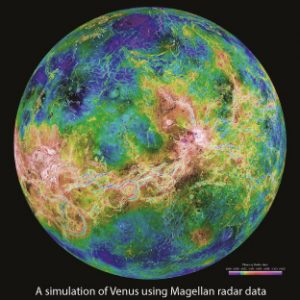Venus
Venus is the brightest heavenly body in our night sky after the Moon and has sometimes been called the morning or evening star. It is surrounded by a dense, cloudy atmosphere, consisting of mainly carbon dioxide and nitrogen, which reflects the sunlight. We cannot usually see through this cloudy layer but NASA’s Magellan mission to Venus used radar to take images of the surface. Venus is similar in size to the Earth, with an equatorial diameter of 12,104km (7,521 miles). Venus rotates in the opposite direction to the other planets, so on Venus the Sun rises in the west and sets in the east. Venus takes 225 days to orbit the Sun and 243 days to complete each rotation about its axis, making each day on Venus 117 Earth days long. Its surface is made up of volcanoes and plains, the two major plains being Ishtar Terra and Aphrodite Terra.
The Russian spacecraft Venera 13 landed on Venus but only survived for 127 minutes due to the immense crushing pressure and high temperature on the surface.
The planet Venus is named after the Roman goddess of love and beauty.

